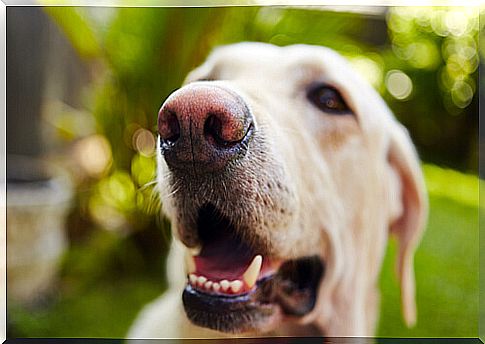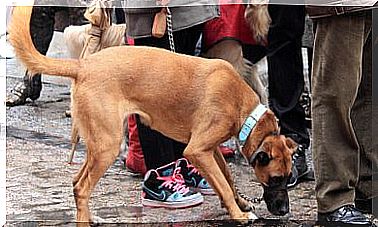This Is How Dogs Sweat

Our pets have glands. This is how dogs sweat, all over their body. The source of sweat is said to be on the foot pads. But you also have to take into account that they expel heat through the mouth.
Among the mechanisms that dogs use to expel sweat and eliminated heat, is panting with the mouth and the elimination of steam through the tongue.
Dogs sweat through the pads

Our pets have tiny sweat glands on their paw pads. There are also cells there that help the dog cool off. There is a layer of fat that works as an insulator from high temperatures, and that contains a sweating mechanism.
The way dogs cool themselves is produced by a natural mechanism that orders the veins in these areas to dilate or expand. If the ambient heat is not excessive, this helps to lower the temperature of the dog’s blood.
Another part for dogs to adjust to their body temperature is their ears, which can dilate or expand as needed.
As we see in the analysis of how dogs sweat, they do not sweat like human beings. However, they have other tools to cool off and measure body temperature.
How dogs sweat. Temperature and hydration
Although dogs have their own sweating mechanisms, do not forget to hydrate them frequently. It is done so that they do not have health problems. In addition, that way they will improve your mood.
The body of dogs works like a refrigerator. Its normal temperature ranges between 38ºC and 39ºC. The animal detects when there is excess heat and pumps warm blood to the tongue, which is armed with efficient salivary glands, which remove excess temperature in the form of moisture. With this, the dog expels the heat through the evaporation that it produces in its mouth.
When you stick your tongue out, the hot water vapor that comes from the lungs condenses when it touches the colder mucous membranes of the mouth and tongue. In this way, the vapor that condenses into liquid water falls from the tongue and drips onto the ground.
The size of the dogs
Large dogs cool less than small ones, among other things because they sweat less. Their large size makes them generate more heat than they are sometimes capable of expelling.
On the other hand, small dogs are more sensitive to high ambient temperatures. High temperatures are very dangerous for them because of their difficulty in sweating, which makes them easy targets for deadly heat strokes.
The heat golge
The internal temperature of the dog can rise above 42 degrees and then suffer a heat stroke that puts its life at risk. The severity of the consequences will depend on the body temperature reached and how long it has been maintained.
Heatstroke usually occurs in the car. To avoid this, you have to turn on the air conditioning and open the windows. It also works to place bags with ice in the animal’s transport to prevent its body temperature from increasing.
We should not, under any circumstances, leave the dog alone in the car. In a few minutes, the vehicle reaches very high temperatures, even if it is parked in the shade and with the windows ajar. Without our being aware, it will be a death trap for the pet.
Symptoms of heat stroke
Dogs that suffer from heat stroke present symptoms such as panting, rapid heartbeat, elevated body temperature, congested mucous membranes, vomiting, diarrhea and sometimes shock or loss of consciousness.
If we observe these signs, we must go to the veterinary clinic as soon as possible. The first measures that we can carry out are to place it in a cool and ventilated place, bathe it with cold water and, if it is conscious, give it to drink small amounts of fresh water.
How dogs sweat, the cooling process

After a few years, scientists have discovered that the internal thermostat of dogs, the thermoregulatory system, is activated by pumping warm blood to the tongue. In addition, the salivary glands open, causing rapid, shallow breathing.
As the warm air flows through the windpipe and tongue, it helps evaporate moisture, which removes heat from the dog’s blood. This process lowers body temperature and helps cool the brain.









